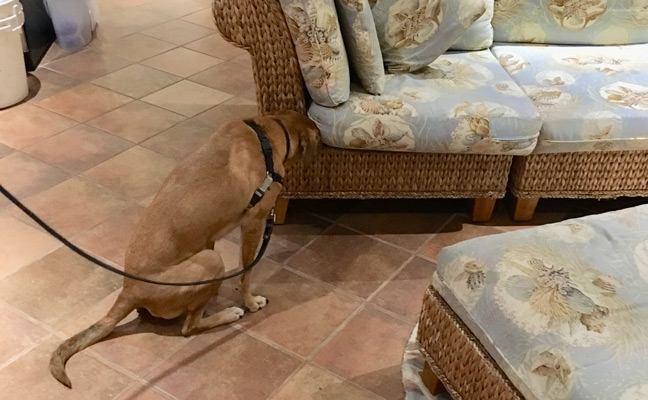
PHOTO: DAVID LATIMER
Last time, we discussed some of the traits that I’ve identified over the years as important for a detector dog to possess. In this segment, we’ll make a hypothetical trip to a shelter to evaluate candidates. (Editor’s note: Read part one here, “How to choose a dog for scent detection”)
I should warn you before you make a trip to your local shelter. It isn’t easy to walk by cage after cage, making eye contact with dogs that obviously want nothing more than to go home with you and be your bud, it will tear at your heart. One way to help with this, is to volunteer to help train shelter dogs in basic obedience to make them more likely to be adopted. In lieu of that you can donate money for food and medical supplies. Neither of these will make walking by dogs any easier emotionally, but at least you’ll know you have done what you could to help them.
On arrival at the shelter, I’ll walk down the aisles between cages and simply observe the dogs and their reactions to my presence. I’ll note which dogs seem energetic and are about the right size for the program. I may stop at a cage door when a dog exhibits a high level of excitement. Some dogs will run to the gate, eager to sniff and lick my hand, barking excitedly, almost as if to say “pick me, pick me.” These dogs would be ones that I’d stop and interact with for a moment. I’ll speak to them in an excited, high-pitched voice while offering the back of my hand for a sniff. I’ll bounce a ball while standing in front of the cage and observe the dog’s reaction. I’ll toss a piece of food into the kennel to see if the dog scrambles to get it. My ideal candidate is one that is crazy for a toy and a piece of food.
If a dog growls when I approach the cage door or retreats to the back of the cage and into its kennel, I can’t use it in my program. I’m looking for dogs that enjoy being with humans. I want dogs that are sociable with other dogs and strangers. Watch the dog closely as it approaches other dogs and people. Does the dog exhibit fear, anxiety, suspicion or potential aggression? Is it happy and excited to meet new friends? Detector dogs that are used in pest detection must be highly sociable and outgoing. The dog should exhibit confidence, but not be overly dominant. It should remain calm and not be over reactive to loud noises.
Taking a dog out of its enclosure, and just going for a walk, is a good way to judge sociability and reactivity to new sights and sounds. Some dogs may know nothing about walking on a leash however, so you may have to improvise a bit. You can use food or a toy to entice the dog to join you.
Knowledge of canine body language is essential in order to conduct a comprehensive test and to remain safe from an accidental bite. There are many books available to assist you in gaining that knowledge. One I highly recommend is “How to Speak Dog,” by Dr. Stanley Coren. Practice what you read and learn to closely observe dogs to become proficient.
If the dog passes our evaluation for friendliness and sociability, it’s time to move on to drive testing. In the next segment, we’ll discuss evaluating a dog for toy drive.
David Latimer is founder of the World Detector Dog Organization, online at WDDO.org. He can be reached at latimer_david@yahoo.com.
Leave A Comment